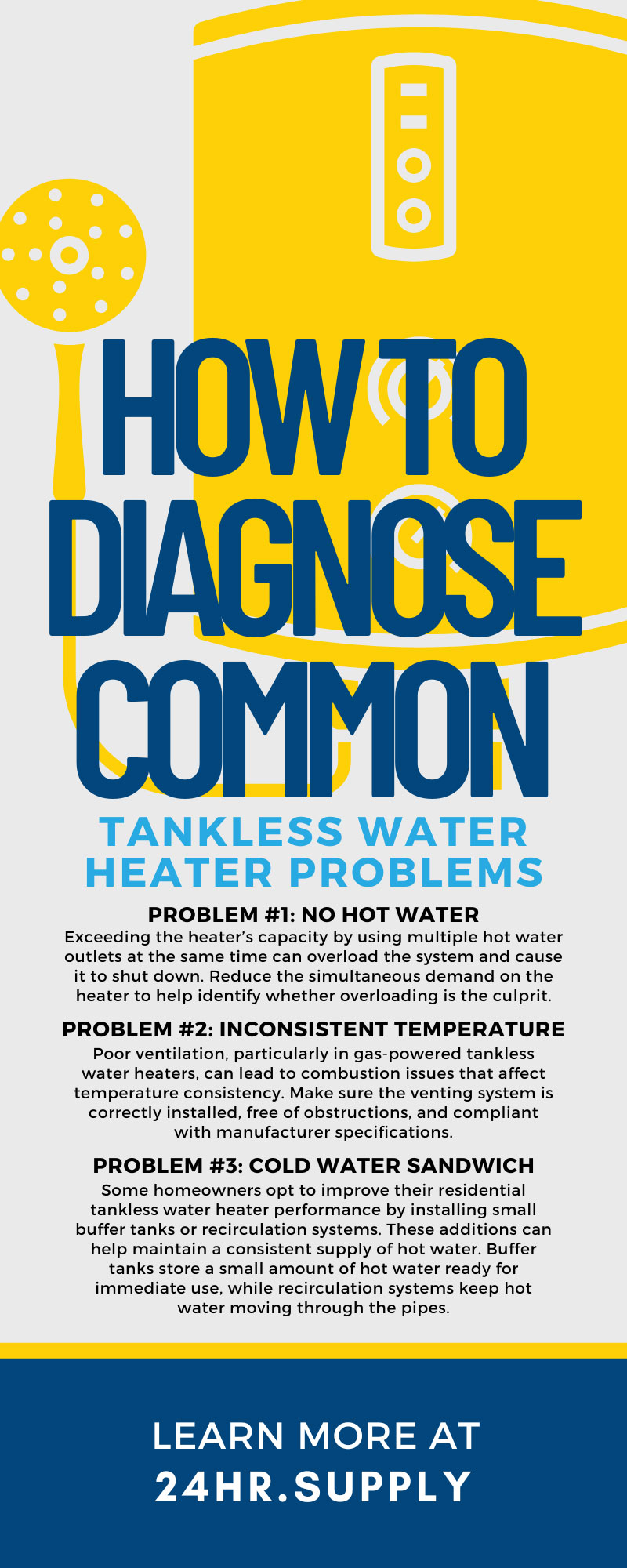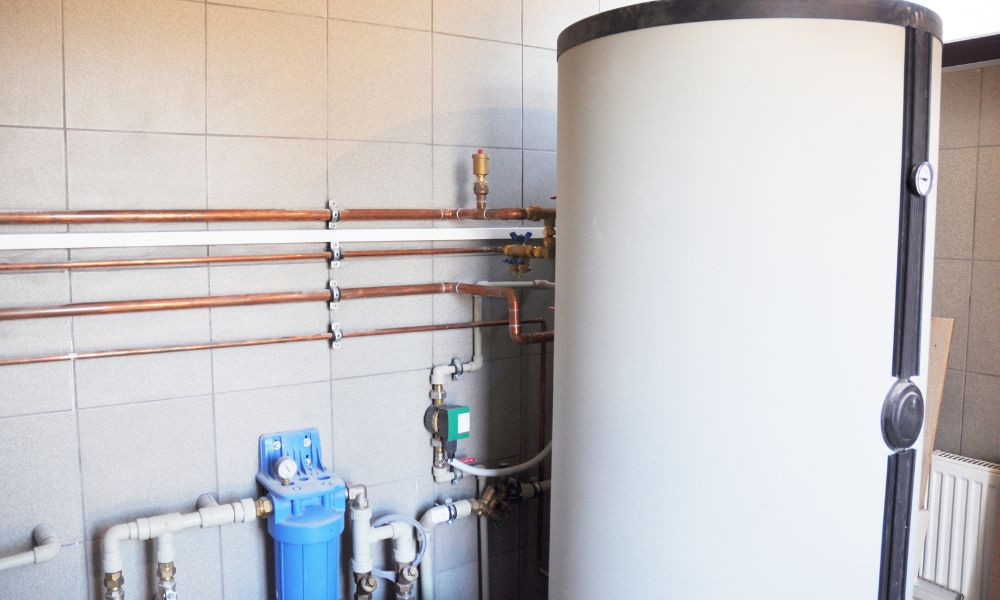How To Diagnose Common Tankless Water Heater Problems
The allure of endless hot showers and the promise of reduced energy bills have made tankless water heaters a favorite among homeowners. Sleek, efficient, and designed to provide hot water on demand, these modern marvels are a game-changer in residential comfort.
Yet, like all sophisticated technologies, they’re not immune to occasional hiccups. From the perplexing cold water sandwich effect to the baffling disappearance of hot water just when you need it most, tankless systems can present a range of annoying issues.
Understanding the quirks of your tankless system doesn’t require a degree in mechanical engineering. With a keen eye and a bit of know-how, diagnosing common tankless water heater problems becomes an exercise in savvy issue-solving. Delve deep into the world of tankless water heaters and unravel the mysteries behind their most common issues to arm yourself with the knowledge to tackle these challenges head-on.
How Do Tankless Water Heaters Work?
Tankless units, unlike traditional tank heaters that store and reheat water, heat water directly on demand. This method is more energy-efficient and provides a continuous hot water supply without the limitations of a storage tank.
The core of a tankless water heater is its heat exchanger, activated by water flow when you turn on the hot water tap. This exchanger heats water to the desired temperature as it passes through, powered by either electricity or gas. The instant heating capability makes hot water constantly available, though the system’s capacity can be tested during high demand periods.
Tankless heaters are celebrated for their efficiency, as they eliminate the standby energy losses typical of tank systems. They only operate when hot water is needed, adjusting the heating element’s activity through sophisticated sensors and control panels.
Problem #1: No Hot Water
When your tankless water heater ceases to deliver hot water, a few common issues are usually at play. Start by pinpointing the root cause through a process of elimination.
System Overload
Exceeding the heater’s capacity by using multiple hot water outlets at the same time can overload the system and cause it to shut down. Reduce the simultaneous demand on the heater to help identify whether overloading is the culprit.
Heating Element Failure
A gas heater may experience ignition failures, indicated by specific error codes on the unit’s display. Electric models might experience heating element failures, also potentially flagged by error codes. These components are critical for starting the heating process, and their malfunction can halt hot water production.
Component Malfunctions
A malfunctioning flow sensor or control board can prevent the heater from activating, as these components are essential for detecting water flow and managing the heating process. These issues typically require professional assessment and repair due to their complexity.
Problem #2: Inconsistent Temperature
Inconsistent water temperature is a common issue that plagues many tankless water heater users, manifesting as unexpected fluctuations between hot and cold during use. This problem may signal underlying issues with your system.
Improper Ventilation
Poor ventilation, particularly in gas-powered tankless water heaters, can lead to combustion issues that affect temperature consistency. Make sure the venting system is correctly installed, free of obstructions, and compliant with manufacturer specifications.
Mineral Deposits
In areas with hard water, mineral buildup inside the tankless water heater can affect its ability to heat water efficiently. Calcium and magnesium deposits can accumulate around the heating element and in the pipes, restricting water flow and heat transfer. Descale the heater periodically to mitigate this issue and restore consistent temperature performance.
Inconsistent Flow Rates
The efficiency of tankless water heaters is highly dependent on the flow rate of water through the system. If the flow rate is too low, it might not trigger the heater to activate, leading to intervals of cold water. Conversely, a high flow rate can strain the heater’s capacity to warm the water adequately. Check shower heads, faucets, and other fixtures for flow restrictors or clogs to promote optimal flow rate.
Problem #3: Cold Water Sandwich
A peculiar and often surprising issue encountered by users of tankless water heaters is the so-called cold water sandwich effect. This phenomenon occurs when warm water is swiftly followed by an unexpected burst of cold water before returning to warm again. This can be particularly jarring during activities like showering, leaving users puzzled and seeking solutions.
The root of this phenomenon lies in the operational mechanics of tankless water heaters. When you turn off the hot water tap, warm water remains in the pipes close to the point of use. If you quickly turn it back on, this residual warm water is the first to come out. But as the heater needs a brief moment to activate and heat new water, the following immediate output can be freezing cold until the heater catches up.
You can minimize the impact of this sandwich effect with a few solutions:
Preventive Use Patterns
Being mindful of how and when hot water is used can help. For instance, avoiding turning the hot water off and on in quick succession during tasks can reduce occurrences of the cold water sandwich.
A Buffer Tank or Recirculation System
Some homeowners opt to improve their residential tankless water heater performance by installing small buffer tanks or recirculation systems. These additions can help maintain a consistent supply of hot water. Buffer tanks store a small amount of hot water ready for immediate use, while recirculation systems keep hot water moving through the pipes.
Heater Upgrade
Modern tankless water heaters are becoming increasingly sophisticated; some models are even equipped with features specifically designed to address the cold water sandwich effect. Upgrading to a newer model with this technology can be a more straightforward solution if you want to eliminate the issue altogether.
All That Said…
The knowledge you’ve gathered here equips you with the tools to diagnose common tankless water heater problems as they arise—and to anticipate and prevent them where possible. Remember, the longevity and efficiency of your tankless water heater depend on your vigilance and willingness to engage in regular maintenance. By applying the diagnostic strategies discussed above, you can ensure that minor glitches are corrected before they escalate into costly repairs.
Armed with a deeper understanding of your tankless water heater, you can step into a role where you’re not just a user but a custodian of this sophisticated appliance. This journey into the heart of common tankless water heater problems underscores the importance of informed ownership. Let this newfound knowledge serve as a foundation for a seamless and efficient water heating experience in your home.

Recent Posts
-
How To Diagnose Common Tankless Water Heater Problems
The allure of endless hot showers and the promise of reduced energy bills have made tankless water h …May 3rd 2024 -
Understanding Boiler Types and Applications
Navigating the world of boilers might not be your everyday adventure, but it’s a journey worth takin …May 2nd 2024 -
The Role of Sewage Pumps in Flood Prevention
With their capacity to devastate communities, disrupt lives, and cause extensive damage, floods dema …Apr 19th 2024



